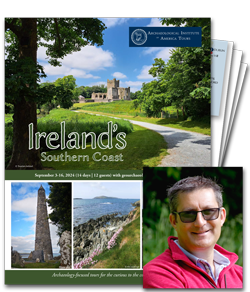
Sponsored by: AIA Tours

This journey takes you through the archaeology, history, and landscapes of Ireland’s southern coast, from east to west. Starting and ending in Dublin, this tour has been designed to give you a deep understanding of the multitude of landscapes and the rich heritage of Ireland, as well as the striking difference between Ireland’s fertile east coast compared to its dramatic and breathtaking southwest. After a gentle start in Dublin, we will head to the sunny southeast and the scene of the Anglo- Norman invasion of Ireland in 1169. There is no better place to understand the impact of this invasion on the existing Irish and Norse populations, and the shifting of political and military power over the following centuries, than here where it all played out. We will then will make our way along the south coast, stopping in Waterford, Cork, and West Cork, with an overnight in Killarney before heading back to Dublin. We will explore hidden archaeological sites from earliest prehistory to the Iron Age (Celtic Period), through early Christian sites to the later medieval period and Ireland’s more recent history, all in the company of highly respected academics, engaging guides, and a tour manager. Travel in a small group and enjoy the personal attention and service of a highly respected Irish academic lecturer/host Dr. Stephen Mandal, who is both a geologist and archaeologist.
Highlights include:
– Visits in Dublin to the National Museum of Ireland and The Irish Emigration Museum.
– Exploring the Hook Peninsula, starting with a visit to Hook Head, home to the world’s oldest operational, fully intact lighthouse (at over 800 years old), set in a dramatic landscape. Afterwards, we drive the short distance
to Tintern Abbey, a Cistercian abbey founded ca. 1200, where several important ruins survive, including parts of the nave, chancel, tower, chapel, and cloister. Enjoy lunch, tour the ruins, and walk in the beautiful Victorian
gardens.
– A guided tour of the Dunbrody Famine Ship an authentic reproduction of an 1840s emigrant vessel that provides a world-class interpretation of the famine emigrant experience.
– Visit the spectacular Charles Fort, a wonderful example of a star-shaped, 17th-century fort. As one of the largest military installations in the country, Charles Fort has been associated with some of the most momentous
events in Irish history, the most significant of which were the Williamite Wars (1689-91) and the Civil War (1922-23).
– Seeing the Bronze Age Drombeg Stone Circle. Drombeg is probably Ireland’s most famous stone circle, consisting of 17 pillar stones that are graded from the two large portal stones, each nearly seven feet high, at the
northeast towards the recumbent stone to the southeast.
The pace of this tour is MODERATE: Must be able to walk one to three miles per day on mostly flat, but often uneven, terrain. For further details and questions, please see the “What to Expect” section of the brochure.
Notifications